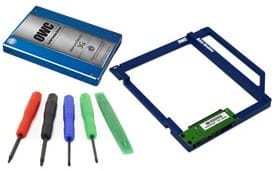 By Aaron Sumner, Guest Blogger
By Aaron Sumner, Guest Blogger
I just replaced my MacBook Pro’s original 350 GB hard drive with a 240 GB solid state drive from Other World Computing, installed with the Data Doubler bracket.
While I was at it I figured I’d go ahead and install a fresh copy of Mountain Lion on the new drive (upgrading from Lion on the old drive). I’m almost two days into the upgrade and wanted to share my experiences so far.
First off, some rationale: Why upgrade my drive instead of my computer, and why go with a Data Doubler instead of just swapping the drives? First off, while I admittedly covet the 13-inch Retina Display, I was hoping to get at least another year out of my old Core 2 Duo-based model. I’ve had the RAM maxed out since the day I bought it, so the next feasible update was a faster and/or larger hard drive. I’d initially thought about swapping the stock drive with a solid state drive and putting the stock into an external enclosure, but realized that would mean having to tote an external drive around whenever I wanted access to my photos or music. Not ideal. I also thought about just dropping as large of a hard drive as I could buy into the laptop, but figured that wouldn’t get me anywhere in terms of speed.
The Data Doubler, coupled with an external optical drive enclosure, turned out to be ideal. I’ve now got 590 GB of total space. My operating system, apps, and day-to-day files are on a fast SSD, and my media have plenty of room on a drive that’s now media-only.
One more note on justification: I went with OWC’s base-level Mercury Electra 3G line of SSDs, for two reasons: First, the optical bay in my laptop won’t support faster speeds (read the fine print on the OWC site); and second, I didn’t want to throw too much money into an aging Apple device. I am, though, fine with spending around $300 to boost both speed and overall storage, while keeping an optical option in the process. As a longtime fan of Other World Computing (they did help me keep a Sawtooth-based G4 tower going well beyond its prime, after all), I trust them to have quality products designed to work with Macs out of the box. This experience has been no exception.
Installation
Hardware installation was smooth – in under 30 minutes I had my optical drive removed, replaced with the Data Doubler bracket and a 240 GB solid state drive, and said optical drive installed in an external case. That said, if you’ve never cracked open a computer before this probably isn’t the best way to get your feet wet – I would recommend getting some help. If you’ve ever swapped out a hard drive before, though, this is in your wheelhouse. The package itself includes a detailed, step-by-step guide. I also found it helpful to watch the video provided by OWC.
Mountain Lion
So far the only issue I’ve had has nothing to do with the hardware but with how the Mac App Store saw my new configuration. Since I hadn’t yet erased the old hard drive while I was getting up and running, the App Store thought I’d already had my purchased apps installed. To work around this I had to add the old drive to Spotlight’s privacy settings (System Preferences -> Spotlight -> Privacy), reboot, and unmount the drive. After I did that and fired the Mac App Store back up I was able to install my apps fresh.
I have to say it was nice having my old data on a drive already mounted and in the actual laptop–it was simple to grab the data I needed and move it over to the new drive.
Media disk
I’m now using my factory-installed drive as a media disk. It houses my iTunes library, my iPhoto library, a few disk images I want to hold onto and videos I intend to watch someday. (Note: To tell iTunes and iPhoto where your media files are located, hold down the option key as you open them.)
While these files along with my system and regular document and code-like files were crowding the drive, when the non-media have been moved over to another drive I’ve got room to spare. This is the real beauty of the Data Doubler, in my opinion – I’ve got my media, and I’ve got it right here. No regretting that I didn’t bring that external drive along when I want to listen to a certain album or show off some certain photos. And yeah, I’ve got hundreds of CDs yet to rip–but thanks to the optical drive enclosure I added to my order it’s just a matter of plugging in the drive.
Results
I’ll admit to running a speed test app, but it didn’t tell me a whole lot – and I’m more interested in real-world results, anyway. So here are a few:
- My Mac boots in about four seconds now. Not that I have to reboot all that often, but seriously, four seconds.
- Keynote starts in under a second. Ditto Pages, Numbers.
- iTunes goes from zero to ready to rock in under two seconds.
- An automated test suite for a Rails application, written in RSpec and hitting the database rather heavily, went from upwards of seven minutes down to two minutes, ten seconds. Believe it or not, those four-plus minutes of saved time alone made the purchase worth it for me, as I run that suite several times per day.
All in all, I’m incredibly pleased so far with my $300 investment. While I’m sure I could have gotten a 240 GB SSD drive for less money if I’d shopped around, the fact that OWC focuses on Mac-based upgrades (and has for so long) I’m confident that I won’t have any problems with this drive running in my Mac. If you’ve got an aging MacBook (or any Mac, for that matter) I strongly recommend checking out Other World Computing’s offerings. They may just have a product to help you eke a little more time out of your old computer.
This post originally appeared at aaronsumner.com/2012/12/owc-data-doubler-mercury-3g/ and is reprinted with permission.
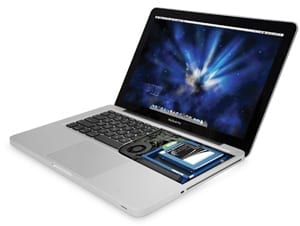
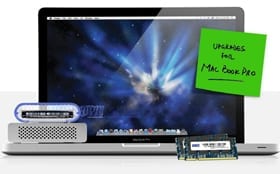
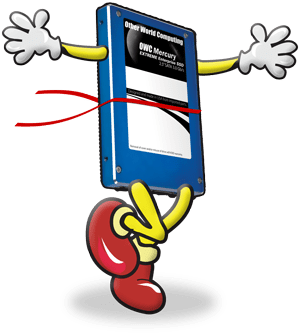
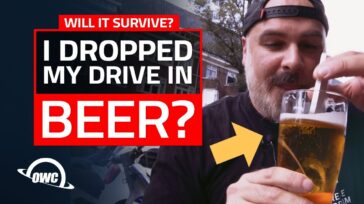
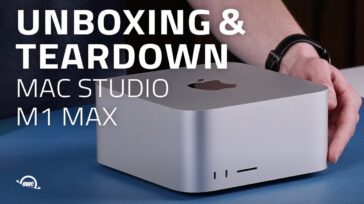
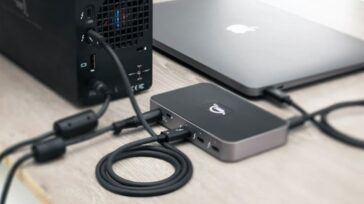
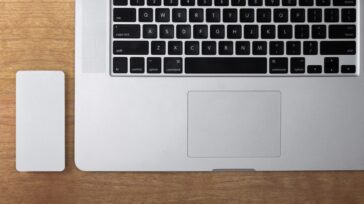


I had an option of replacing my aging Macbook Pro (early 2011) with a new one. But the costs looked too daunting and I just couldn’t do without my Macbook Pro. I weighed all the options and realised that a Data Doubler upgrade is a risk worth taking.
And when I got down to it I realised it was not a risk at all! The DIY videos are just too good. In half an hour I had replaced my 500GB HDD with a 2.0TB SSD and replaced my dysfunctional DVD Drive with the HDD. The whole exercise was a cinch and my lumbering Dakota of a Macbook Pro is now converted into a turbo Concorde. Work is a pleasure now as against the endless waiting earlier.
Thank you OWC – you’ve turbojacked my life!
Hi, Deepak. That’s great to hear! Thanks for the kind words.
Hi Aaron,
I’ve got a mid 2010 (7.1) macbook pro and I’m thinking of the Data Doubler option. First, the OWC video show the SSD installed in the Optical drive location…is this for a reason? I’ve been reading articles and there appears to be problems with using the optical drive externally with the USB kit. I burn a lot of movies to CD so I rely on the optical drive. I don’t want to get into some of the software gymnastics solutions I’ve seen as I’m not a long time Mac user.
– Will I have problems with an external USB optical drive with the data doubler?
-Would installing an SSD into the optical drive improve performance or must I install into the old HDD spot?
I want to keep this as simple as possible and I’m looking for performance increase, external USB optical drive full function and simplicity (minimal software fiddling).
I’m holding back on the install until I can figure things out.
Thanks
The Data Doubler is the chassis for installing a 2.5″ SATA drive into the optical bay of your compatible MacBook/MacBook Pro.
If you use your optical drive extensively, then this is probably not the solution for you for adding additional storage to to your MacBook Pro. For your situation, as you’re looking for additional speed, then upgrading your current hard drive to a Mercury Electra 3G solid state drive is your best bet.
Then, for additional storage, you would want to go with an external drive.
Hello,
I have a late model MacBook Pro 17″ specifically MacBook Pro 4,1 2.5 GHz Intel Core 2 Duo. I was looking over OWC’s website for some data doublers option but didn’t see one listed that compatible to my MacBook Pro.
Can you offer a recommendation? Thanks for your time
Unfortunately, the earliest model 17″ MacBook Pro that can take the Data Doubler is the Mid 2009 model (MacBookPro5,2). The newer model Macs have a SATA interface, which is what the Data Doubler uses to attach a standard SATA drive. Earlier models, like yours, have ATAPI optical drives, which are incompatible with the Data Doubler.
Hi Aaron,
Great article!! I am just wondering if there is any difference between having the SSD or the HDD installed with the data doubler?? Obviously, I want to use the SSD to run the OS and apps and use the HDD for music, movies and files. But I am not sure if the location of the SSD would have any impact on its performance…
Hi Aaron, I’m happy to have come across your blog. I have a late-2008 aluminium unibody 13-inch MacBook. It only has a 250GB hard drive and I’m now running on about 12 GB available space:-( I really can’t afford a new computer and was wondering whether the OWC Data Doubler solution might work for me (even though the $229.99 for the 240GB SSD is more than I wanted to pay)?
I was wondering if I retain my existing 250GB HDD as a Media Only drive (I have 150GB in my iPhoto Library and 38GB in iTunes Library) I might be able to get away with buying a 120GB SSD and do as you have suggested, i.e. have the OS and applications files on a the 120 GB SSD? I’m running Lion 10.7.5.
The late 2008 unibody MacBook is fully compatible with the Data Doubler solution. Keeping your Mac OS and Applications on the SSD and your personal data on the media drive is a very common setup. We offer a How-To video to accomplish this setup.
great post. i want to do it as well in the next few days
@ Sergio. I have also installed an SSD 240GB Mercury Electra 3G in my 2009 MBP. Everything got dramatically faster, after clean instal of ML boot time is 22 seconds.
Hi Aaron,
Great post, I did the same thing and replace my hard drive with an SSD 240GB Mercury Electra 3G Line from OWC, the shipping was super fast. I have a late 2008 Macbook 2.4 ghz Intel core 2 duo, but my boot time is 25 seconds (without any applications installed), I did a clean install, do you thing I did something wrong? and what do you know about enabling TRIM to extend the life of your SSD? The difference in boot times its huge (4 sec vs 25 sec).
Thank you.
Sergio